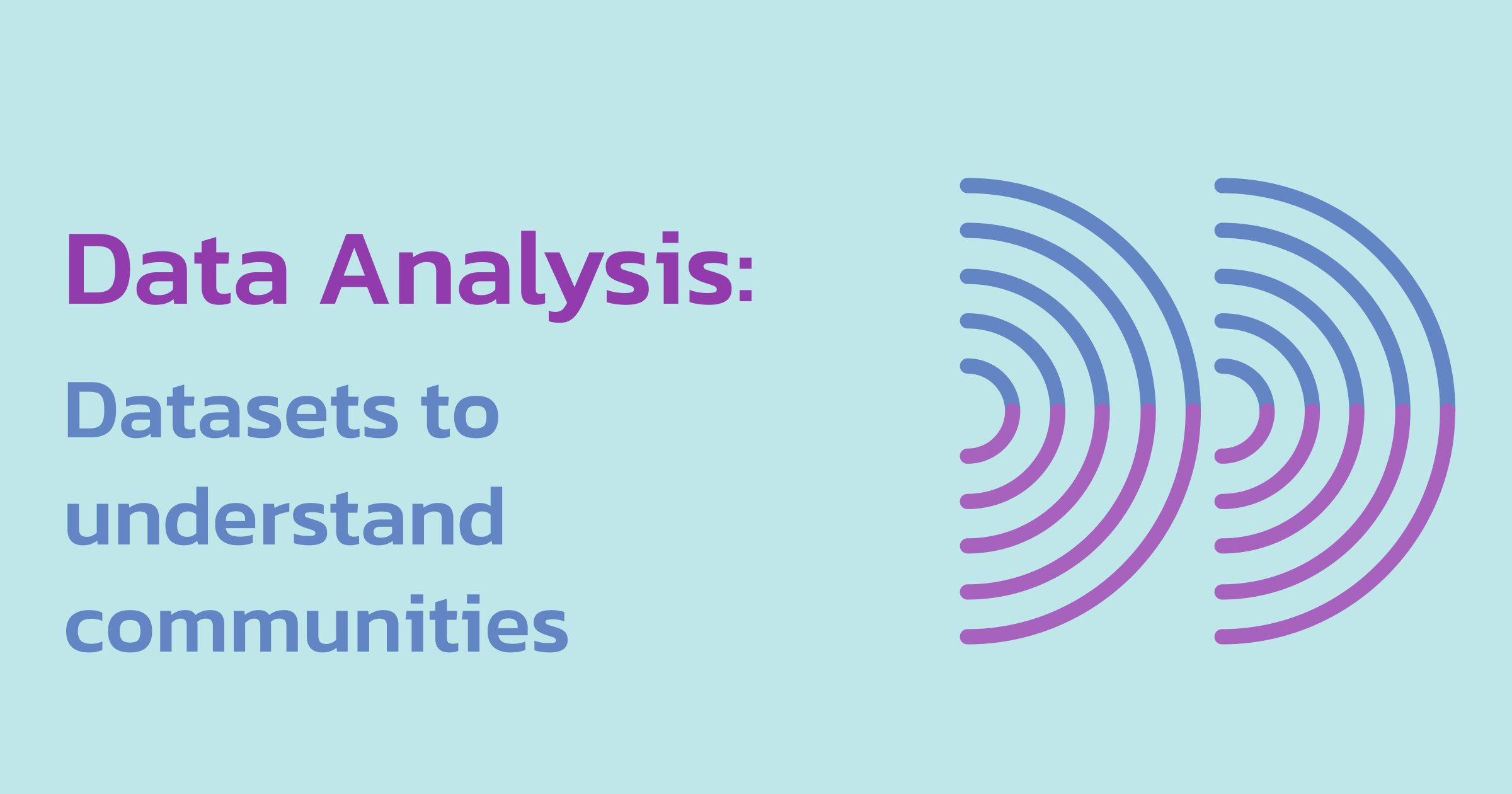
We are very excited to report that the first datasets from Census 2021 have been released today, covering census population estimates. The following datasets were published for England and Wales at national, regional and local authority level:
- Usually resident census population estimates, by five year age bands and sex
- Population density
- Occupied households
Each of these datasets is rounded to the nearest 100.
This first release provides us with data that will be used to underpin a whole range of key socio-economic statistics. This data will provide the denominator for a full range of key statistics from DWP benefit claimant rates, to recorded crime rates, to per capita measures such as GDP, to more recent indicators such as prevalence of COVID-19 in the community.
What do the census population estimates tell us about England and Wales?
- 59,597,300 people were identified as living in England and Wales on Census 2021 day
- The total population in England and Wales is 59,597,300 (30,420,100 females (51%) and 29,177,200 males (49%). Of these, 56,489,800 live in England (94.8%) and 3,107,500 live in Wales (5.2%).
- There are 24,782,800 households across England and Wales, with an average of 2.4 persons in each household.
- Approximately 23.1% of the population are aged under 20, while 18.6% are aged 65+.
- There are an extra 3.5 million people living in England and Wales in 2021, compared with 2011.
- The population in England and Wales has increased from 56,076,000 in 2011 to 59,597,300 in 2021 (an increase of 6.3%). This is slower than the rate of increase between 2001 and 2011 (7.8%).
- As might be expected, the increase is fastest among older age groups, with the population aged 65+ increasing from 9,223,000 in 2011 to 11,063,400 in 2021 (an increase of 20.1%).
What do the census population estimates show regionally?
The South East is the largest region by population.
- The South East is the most populous region with 9,278,100 people, followed by London (8,799,800 people). Just under one-third (32.0%) of all people in England live in London or the South East.
- The North East is the smallest region in England and Wales, with a population of 2,647,100 (comprising 4.7% of the England population).
The East of England has experienced the largest population increase, with faster population growth in the South and East
- The East of England has experienced faster growth in population than the other regions, with the population increasing by 8.3% between 2011 and 2021.
- Generally, the South and East have seen greater population growth, with the South West, London, South East and The East Midlands regions also growing at a faster rate than the national average. By contrast, Wales and the North East experienced much smaller increases of 1.4% and 1.9% respectively over the same period.
London has the highest proportion of young children, while the South West has the highest proportion of older people
- London has the highest proportion of young children, with 6.0% of the population aged under 5. At the other end of the scale, only 4.8% of the population are aged under 5 in the South West.
- Balancing this, the South West has the highest proportion of people aged 65+ (22.3% of all people). By contrast only 11.9% of the population are aged 65+ in London.
London has the highest level of population density
- Unsurprisingly, population density is significantly higher in London than across the other regions, with 5,598 persons per square km. The North West, South East and West Midlands regions also have higher levels of population density than the national average (526, 486 and 458 persons per square km). By contrast, Wales has a population density of 150 persons per square km (lower than any other region).
What do census population estimates show across Local Authorities?
Birmingham is the largest Local Authority in England and Wales
- Birmingham has the largest population of any Local Authority, with more than one million residents (1,144,000 people). A further eight Local Authorities have a population of 500,000 or greater: Leeds (812,000), Cornwall (570,300), Sheffield (556,500), Buckinghamshire (553,100), Manchester (552,000), Bradford (546,400), County Durham (522,100) and Wiltshire (510,400).
- And at the other end of the scale, four Local Authorities have a population of 50,000 or fewer: Isles of Scilly (the smallest Local Authority with 2,100 residents), City of London (8,600), Rutland (41,000), and Richmondshire (49,700).
Tower Hamlets experienced the largest increase in population between 2011 and 2021
- Looking at changes at Local Authority (LA) level, the largest increase between 2011 and 2021 was across Tower Hamlets where the population increased by 22.1% between 2011 and 2021. A further 11 LAs experienced population increases of greater than 15%: Dartford, Barking and Dagenham, Bedford, Cambridge, Peterborough, City of London, Tewkesbury, Central Bedfordshire, Salford, Milton Keynes and Wokingham. All bar one of these (Salford) were located in the South or East of England.
- By contrast, 18 Local Authorities experienced a fall in population between 2011 and 2021. Kensington and Chelsea experienced the largest population decline, with the population contracting by 9.6%. This may be partially attributable to the timing of the census with atypical residency patterns during Covid-19. Similarly large falls were also evident in other central London boroughs including Camden and Westminster.
Barking and Dagenham has the highest proportion of young children
- Barking and Dagenham has the highest proportion of young children, with 7.9% of the population aged under 5. The Local Authorities with the highest proportion of young children tend to be located in areas in outer London and the London fringe, with nine of the ten areas with the highest proportion of children aged 0-4 located in outer London Boroughs (Barking and Dagenham, Newham, Redbridge, Waltham Forest) or Local Authorities within the London commuter belt (Slough, Dartford, Thurrock, Luton and Harlow).
- Local Authorities with the lowest proportion of young adults tend to be in more rural areas, particularly in coastal communities. Four of the five Local Authorities with the smallest proportion of 0-4 year olds are in rural areas (Ceredigion, South Lakeland, North Norfolk, Derbyshire Dales). However, the Local Authority with the lowest proportion of 0-4 year olds is the City of London, where only 2.3% of the population are aged 0-4.
Oxford has the highest proportion of young adults
- Oxford has the highest proportion of young adults, with nearly one-in four people in Oxford(23.4%) being aged 15-24, driven by the large student population in the city. Other University cities also have higher-than-average proportions of young adults, with more than one-in-five people aged 15-24 in Nottingham (23.3%), Cambridge (21.9%), Exeter (21.6%), Lincoln (21.6%) and Newcastle upon Tyne (20.0%).
- By contrast, there are lower proportions of young adults in coastal retirement areas, with fewer than 5% of people in the Isles of Scilly aged 15-24.
North Norfolk has the highest proportion of older people
- North Norfolk has the highest proportion of people aged 65+, with one-in-three residents (33.4%) aged 65 and over. Each of the 13 Local Authorities with the highest proportion of people aged 65 and over are on the coast.
- By contrast, only 5.6% of the population in Tower Hamlets (the fastest growing Local Authority – see above) are aged 65+.The ten Local Authorities with the lowest proportion of people aged 65+ are all located in London.
Tower Hamlets is the most densely populated Local Authority in England and Wales
- Tower Hamlets is the most densely populated Local Authority in England and Wales, with an average of 15,695 persons per square km. Each of the 20 most densely populated Local Authorities in England and Wales are located in London. Luton is the most densely populated Local Authority outside of the capital.
- Eden (in the Lake District) and Powys (Mid Wales) have the lowest population density of any Local Authorities with 26 persons per square km.
Details of the indicators
- Usual Resident Population: For the 2021 Census, a usual resident of the UK is anyone who, on census day 2021, was in the UK and had stayed or intended to stay in the UK for a period of 12 months or more, or had a permanent UK address and was outside the UK and intended to be outside the UK for less than 12 months.
- Population by age: The age of a person is derived from their date of birth. It is their age in years on their last birthday up to and including census day 2021.
- Occupied households: The number of households with at least one usual resident. A household is defined as one person living alone, or a group of people (not necessarily related) living at the same address who share cooking facilities and share a living room, sitting room or dining area.
Find out how Census 2021 data can be explored in detail with OCSI’s Local Insight tool.
Featured posts

Research Projects
Following the release of the second Everybody needs good neighbourhoods report, Stefan…
More

Data analysis
The Community Life Survey (CLS) is an annual survey commissioned by the…
More
